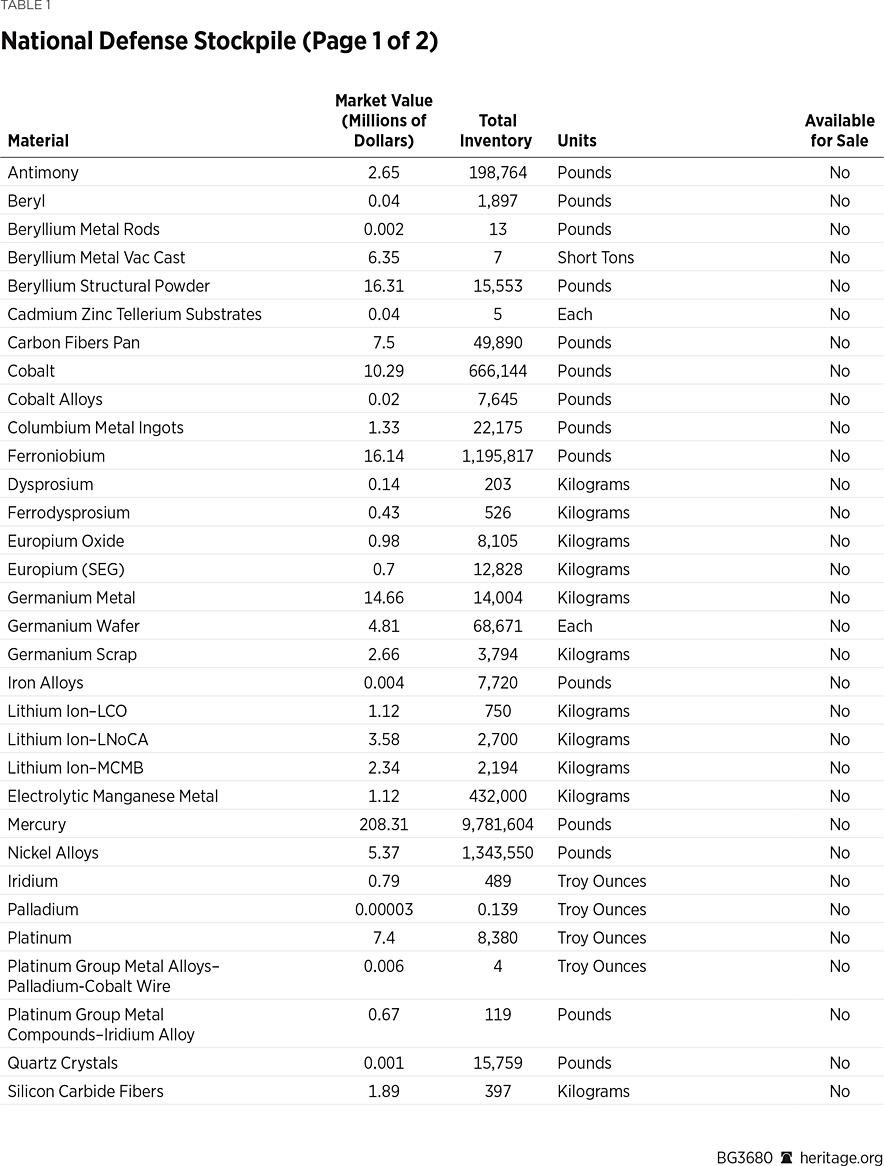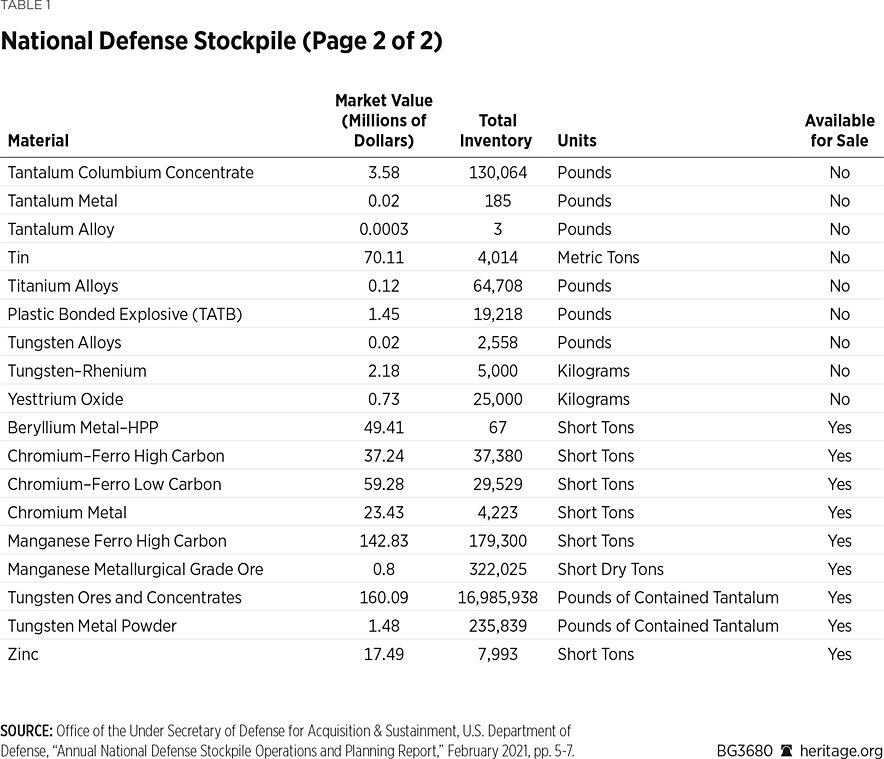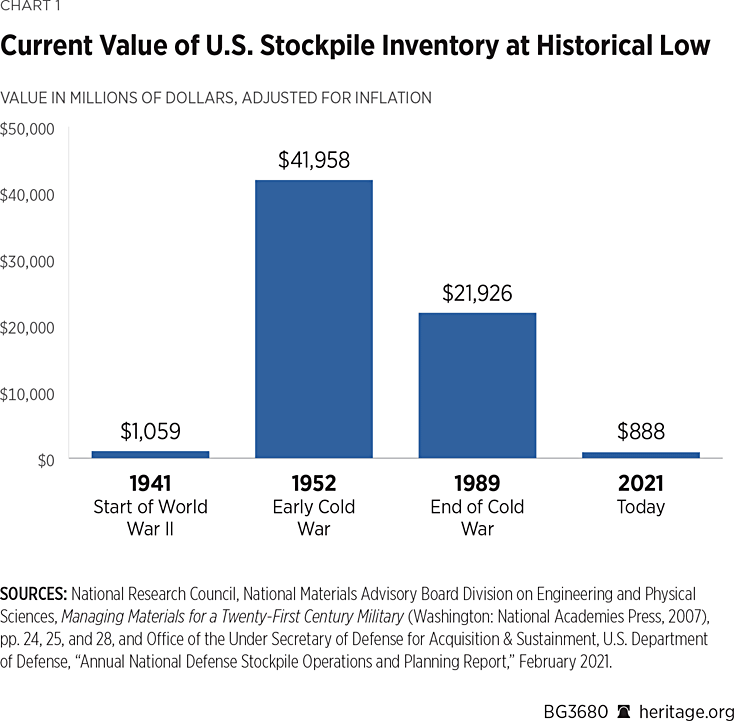U.S. policymakers are intensely concerned about global defense supply chains—and for good reason. Renewed great-power competition has elevated the importance of national defense and the industrial base that supports it. This includes the United States’ sourcing of strategic materials, which are required to build the weapons systems and defense capabilities utilized by the U.S. military. Just last year the COVID-19 pandemic demonstrated the fragility of our access to these materials.
Geopolitics and the nature of the global economy further endanger strategic material supply chains. China—the United States’ chief global competitor—is either the sole supplier or a primary supplier of many of the minerals and materials used in defense manufacturing. Unlike the Cold War, in which the Soviet Union and the United States were economically independent of each other, today the United States depends on China and other Asian countries for numerous strategic materials. This could give China leverage over the United States in a potential armed conflict.
Policymakers, correctly recognizing this problem, have proposed incentives to increase the domestic production of strategic materials, including rare earth elements that are essential to many high-tech devices. These efforts, however, will take years to mature and require significant government intervention in free markets to create sustainable sources. Furthermore, some strategic materials simply cannot be sourced domestically because they are not found within U.S. territory.
The Department of Defense (DOD) already maintains a stockpile of critical and strategic materials known as the National Defense Stockpile (NDS). In a war or national emergency, this stockpile is meant to provide defense and essential civilian manufacturers with immediate access to the raw materials required to produce essential defense goods and services.
This paper provides background on the NDS and its operations today. It reviews the intended purpose of the stockpile and asks whether it is sufficient to meet the needs of U.S. national defense today and in the near future. More specifically, it provides a framework for considering whether the stockpile contains the right materials, in the right quantities, to support the defense and essential civilian industrial base during an armed conflict. This paper also highlights vulnerabilities in stockpile management and provides recommendations on how Congress and the DOD can mitigate those vulnerabilities.
The National Defense Stockpile
The federal government operates several different stockpiles, and these are managed by different federal agencies depending on the stockpile’s purpose. For example, the Department of Health and Human Services manages the Strategic National Stockpile, which contains medicines and medical equipment.REF This stockpile is meant to supplement state and local reserves of these items as needed to respond to public health emergencies. The Department of Energy operates the Strategic Petroleum Reserve—714 million barrels of oil held in salt caverns off the coast in the Gulf of Mexico for use when the international oil market is severely disrupted.REF
Even within the DOD, there are distinct stockpiling efforts that serve different purposes. Each service manages its own stocks of war reserve materiel, which includes munitions and “mission-essential items,” including spare parts, end items such as extra tanks, clothing, combat rations, and fuel.REF
The NDS is a distinct effort managed by the Defense Logistics Agency (DLA), a combat-support agency of the DOD. The stockpile currently contains 42 raw materials, primarily minerals, that are deemed critical to national security.REF These materials include rare earth elements, metals (such as tin, tungsten, and beryllium), ores and compounds, and non-metal raw materials (such as energetic materials and carbon fibers). Table 1 contains the list of the current materials in the stockpile.


The DLA stores the stockpiled materials in six depots located in Hammond, Indiana; Hawthorne, Nevada; Lordstown, Ohio; Point Pleasant, West Virginia; Scotia, New York; and Wenden, Arizona.
History of the NDS
The NDS was established in law under the Strategic and Critical Materials Stock Piling Act of 1939REF to hedge against the supply- and demand-side uncertainties of World War II.REF The stockpile continued to operate (with minor changes) throughout the Cold War. During that time, the size and value of the stockpile grew significantly. The stockpile received infusions of funding throughout the Cold War. As a result, though it had a value of only $54 million in December 1941, its value was $4.02 billion by 1952, and it reached a peak total value of $9.6 billion in 1989.REF
The value of the materials in the stockpile today is far, far less than what it was at the end of the Cold War: The stockpile today is valued at only $887.9 million,REF compared to $9.6 billion in 1989. Adjusted for inflation, the value of the stockpile in 1989 was $21.9 billion in today’s dollars.REF Chart 1 corrects these values for inflation to demonstrate just how much the value of the stockpile has shrunk in the past three decades.

When the Cold War ended, Congress authorized the sale of excess materials in the stockpile, and proceeds of the sales were transferred to other federal or DOD programs, leaving a much smaller stockpile of fewer strategic materials.REF However, the threat environment today is more similar to the Cold War than to the 1990s. As the National Defense Strategy Commission stated in its 2018 report Providing for the Common Defense, “The United States confronts more numerous—and more severe—threats than at any time in decades.”REF This naturally raises the question whether the stockpile should be larger, as it was in the 1980s, or continue at the relatively smaller size it has been throughout the past 30 years.
The Stockpile Today
Today, the NDS still operates according to the original Strategic and Critical Materials Stock Piling Act as modified by amendments.REF The NDS is a strategic stockpile, not an economic stockpile: It is not intended to influence prices in the market or insulate private industry from supply shocks. Rather, its purpose is to ensure that the defense and essential civilian industrial base has consistent access to the materiel it needs—and the private industries making that material have the raw materials they need—in war or national emergency.
According to the law, the stockpile is to contain sufficient materials to support the United States’ defense needs for a hypothetical conflict, plus the materials necessary “for the United States to replenish or replace, within three years of the end of the military conflict scenario…all munitions, combat support items, and weapons systems that would be required after such a military conflict.”REF However, many assumptions must be made in order to calculate these quantities.
Experts at the DLA and the Institute for Defense Analyses (a federally funded research and development center that supports the DLA with stockpile analysis) use economic calculations to determine the availability of materials in the U.S. economy and the military’s demand for those materials in a conflict scenario. This process is explained in the DLA’s annual Stockpile Requirements Report to Congress.REF
Base Case Assumptions. In order to estimate the amount of materials needed for a conflict, the DLA has to have a more specific concept of what that conflict will look like. The Stock Piling Act requires the DLA to “base the national emergency planning assumptions on a military conflict scenario consistent with the scenario used by the Secretary of Defense in budgeting and defense planning purposes.”REF This planning scenario is referred to as the “Base Case.”
The specifics of the Base Case are classified, but certain information is publicly available—for instance, the Base Case is developed in coordination with the military services, the Joint Staff, and the Office of the Secretary of Defense for Policy in order to better estimate the military’s rates of attrition during a conflict.REF
Otherwise, there is very little information available about the Base Case, except for small details such as that the Base Case “includes a military conflict and a homeland defense event coupled with specific assumptions and planning factors.”REF This gives a vague sense of what the Base Case looks like but provides no details that would allow an observer to replicate the calculations that the DLA makes to compute the required material amounts for the stockpile. Given that the 2018 National Defense Strategy focuses on China, one could speculate that the Base Case scenario possibly includes conflict with China—probably over Taiwan—plus a homeland defense event.
Calculations and Assumptions of Material Availability. The DLA must estimate not only the military’s demand for materials during a conflict but also the supply of materials that will be available for defense and essential civilian products. DLA planners use complex economic models to understand how much of these materials are currently consumed in the economy, whether the United States would have access to foreign sources of materials in the conflict scenario, and the degree to which domestic and allied producers could increase production of materials in response to the conflict scenario.REF
Planners then compare the hypothetical supply of materials to the amount required to sustain a conflict and a three-year replenishment. If projected supply is less than projected demand, the difference is the amount of the given material whose vulnerability needs mitigation. This could include purchasing material for the stockpile, recovering materials from end-of-life weapon systems, or qualifying materials from commercial customers to defense supply chains.
Funding the Stockpile
The NDS does not receive annual appropriations in the defense budget—neither for new purchases of materials nor for operations expenses. Instead, the stockpile has a revolving fund in the U.S. Treasury called the National Defense Stockpile Transaction Fund.REF Whenever materials in the stockpile are sold, the proceeds of that sale are added to the fund. The DLA then uses that money to pay for the operational expenses of maintaining the stockpile and to purchase new materials. Information about stockpile transactions—what was bought, what was sold, at what price it was sold—is publicly available in annual and monthly reports published by the DLA.REF
This system worked well enough for the past three decades, when there were plenty of excess materials from the Cold War–era stockpile that could be sold. However, the DLA is rapidly approaching the limits of the stockpile as a self-sustaining funding source. Since 2016, the DOD has warned every year in its budget exhibits that the stockpile will eventually require new funding.REF The fiscal year (FY) 2022 Budget Justification Book stated explicitly: “The remaining quantities of NDS materials that are excess to NDS needs are insufficient to fully finance program cost such as general operations, material acquisitions and environmental liabilities. Current projections indicate that the NDS program will reach an unsustainable point by FY 2025.”REF This makes sense: The transaction fund is really self-sustaining only when the stockage requirements are going down and the stockpile can sell excess materials to pay its operating costs.
The revolving fund system creates an incentive for Congress or the DLA to sell materials that may otherwise be useful or important to have in the stockpile merely in order to be able to keep employing DLA staff and maintaining a healthy cash flow for the agency. As the United States shifts toward great-power competition, it is becoming clear that there is a need for additional fiscal resources to be added to the transaction fund in order to add new commodities to the stockpile and, at the same time, pay its operating expenses.
Assessing the Stockpile’s Adequacy
It is difficult to assess whether the NDS contains the right materials in the correct quantities to best meet the emergency needs of the defense industrial base. In order to conclude that the stockpile is sufficient, one has to assume that:
- The DLA’s planning scenarios do, in fact, align with the planning scenarios used by the rest of the DOD;
- The rest of the DOD is using planning scenarios that properly reflect the National Defense Strategy and National Security Strategy;
- The National Defense Strategy and National Security Strategy credibly assess and respond to the global threat environment;
- The DLA has accurate information regarding the military’s and the defense industrial base’s current consumption of strategic materials and can extrapolate the likely increased demand for strategic materials in a wartime scenario;
- The DLA has accurate information regarding the current supply of strategic materials and can extrapolate their likely availability in a wartime scenario;
- The DLA has correctly calculated the amount of each material that should be stockpiled to meet wartime demand for the duration of the conflict and for the three-year reconstruction period as required in the Stock Piling Act;
- The DLA has acquired, or plans to acquire, the correct amounts of each material according to its own calculations; and
- No other factors—for example, unavailability of funds in the stockpile’s Treasury account, fluctuating prices of materials, or political considerations—influence the DLA’s acquisition and disposal of materials.
Specific information about decision-making processes for the stockpile is generally unavailable to the public, and much of the planning scenario data is classified. The DLA submits other information, such as the Annual NDS Operations and Planning Report, directly to Congress without releasing it to the public.
The most important missing information is the details of the planning scenario. As a result, the public cannot check the DOD’s work; there is no way to confirm the validity of the DOD’s planning assumptions or replicate its calculations.
Congress’s oversight of the stockpile may not be effective. Ultimately, the Stockpile Requirements Report, once submitted to Congress, is reviewed by only a handful of people—one or two professional staff members on the House and Senate Armed Services Committees and maybe a few Members’ military legislative assistants. In this system, funding decisions and material purchases may not receive enough attention, given the NDS’s importance to national security.
In the early 2000s, the National Research Council reviewed the stockpile and found that the DLA lacked “information detailing which materials were forecasted to be required for future weapons systems, domestic production capacity, and alternatives for addressing shortfalls.”REF
The final report recommended making the NDS more adaptable both to the new threat environment (the War on Terror, regional conflicts) and to the more globalized economy. The stockpile was not reconfigured or reformed as a result of the report, however, and besides occasional National Defense Authorization Act amendments in the past 15 years directing the purchase or sale of certain stockpiled materials, congressional interest in the stockpile has waned.
The experience of requiring this report and evaluation of the stockpile, however, demonstrates that Congress can increase its oversight over the NDS. The report further demonstrated that this increased oversight is needed. These in-depth examinations are the only way to test whether the assumptions and calculations behind the stockpile hold up to scrutiny.
Recommendations
Congress should:
- Request an updated independent analysis of the NDS. The NDS is vital to national defense, particularly as the United States trends toward increased dependence on foreign-sourced strategic materials. But in order to properly ensure that the military and industrial base have the materials needed in a conflict, planners must base the size and contents of the stockpile on accurate information and plausible estimates. Congress should use its oversight authorities to ensure the stockpile meets these conditions. Specifically, the House and Senate Armed Services Committees (and more specifically, the Readiness Subcommittees) should require the DLA to contract with a third party (not the IDA) to conduct an independent review of the stockpile and its practices. A review should be performed on a consistent basis—every five years or so—so Congress can maintain effective oversight of the stockpile. Such a review would consider both the quantity and the types of materials to be stockpiled. It would probe whether the NDS includes all the materials needed by the defense industrial base. Section 11.a.6 of the Stock Piling Act already gives Congress the authority to request this information from the DLA. The act could also be amended to require an additional report to Congress.
- Increase the size and number of materials maintained in the NDS. One may reasonably assume that the amount of materials in the NDS today is far less than it was at the end of the Cold War. As the United States reenters great-power competition, it should grow the NDS to reflect this shift.
- Investigate whether a financial “transfusion” of appropriated funds to the NDS is necessary. The funding model for the stockpile is sustainable only when commodity requirements are being reduced, allowing the stockpile managers to sell materials to generate funds. With the transition to great-power competition—especially with China, which has control of much of the world’s minerals—the United States is unlikely to find itself with excess materials in the stockpile for the foreseeable future.
Conclusion
The NDS is a relatively small function of the DOD, but it has the potential to address some of the concerns surrounding defense supply chains; thus, the stockpile has a role to play in the new era of great-power competition. However, for the stockpile to effectively hedge against supply-chain disruptions, it needs to contain adequate stocks of critical materials. This requires accurate calculations based on current realities. Congress should use its oversight and budgetary authorities to ensure that the stockpile will meet the needs of the nation’s defense industrial base.
Maiya Clark is a Research Associate in the Center for National Defense, of the Kathryn and Shelby Cullom Davis Institute for National Security and Foreign Policy, at The Heritage Foundation.



